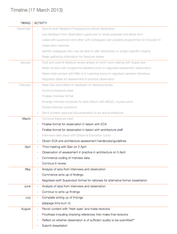|
Whilst doing a research trawl using reading lists from previously completed courses, I've also decided to bookmark feedback on relevant assignments. The idea here is to identify the strengths and weaknesses of work that I've submitted to date. Where flaws or gaps are mentioned within the feedback, I have a helpful reminder of what I need to be wary of and to address. Perhaps the most valuable feedback will be that provided by Sian in response to my those from the EDC10 course. I've reproduced the feedback below and later this week will work through it point-by-point, picking out what I perceive to be significant with a view to my current dissertation project.
At-a-glance, there's some useful stuff there, including links to some potentially useful literature on text and scholarship.
0 Comments
Leave a Reply. |
Categories
All
Archives
October 2013
TimelineOther stuff
|
